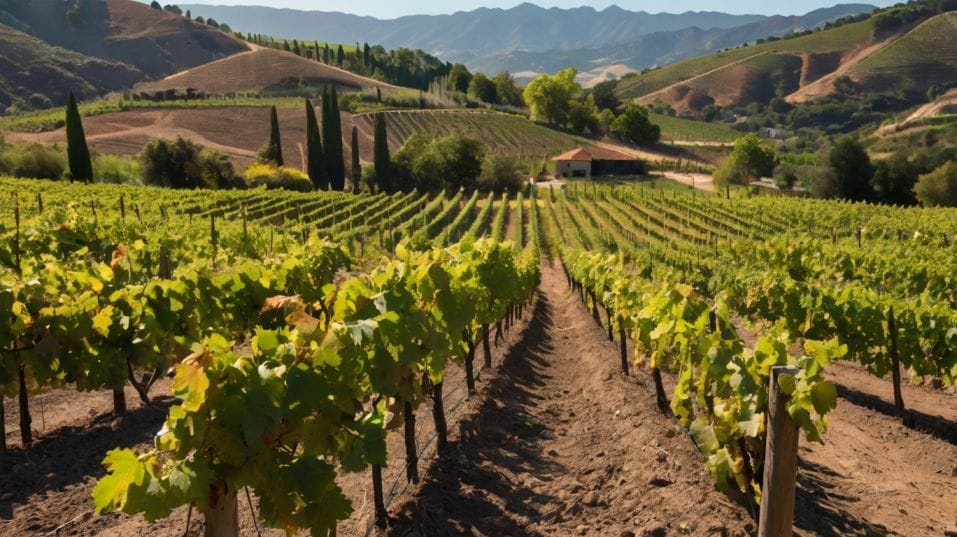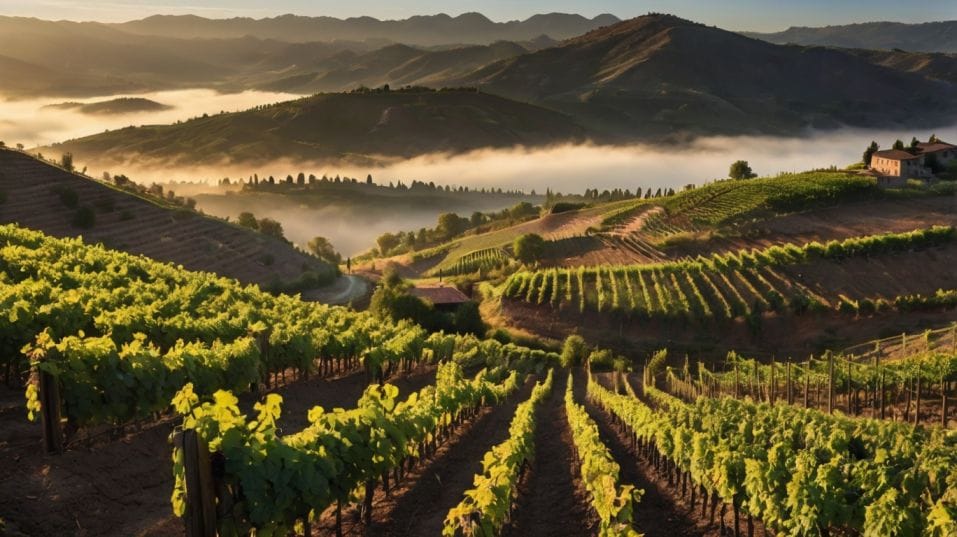How Geography Shapes Flavor
Curious about wine? Learn how geography shapes flavor—soil, climate, slope, and culture all guide what ends up in your glass.

Ever wonder why the same grape can taste wildly different from one bottle to the next? The answer lies beneath your feet—and above your head. From soil to sunlight, geography shapes wine in ways no winemaker can fully control.
If you're just starting to explore wine seriously, learning how place influences flavor isn’t just helpful—it’s essential. This guide unpacks the hidden forces that shape what ends up in your glass and why it matters every time you sip.
The Soil Is Never Just Soil
Dig a little deeper—literally—and you’ll find that soil isn’t just a detail. It’s the stage on which the entire drama of a vintage unfolds.
Different soil types change the way vines grow, how grapes ripen, and what kind of structure and flavor a wine develops.
Limestone, for instance, holds moisture in dry climates and helps maintain acidity. Wines from limestone-heavy soils—think Chablis, Champagne, or parts of Rioja—often feel bright, clean, and linear.
Volcanic soils, like those on Mt. Etna or in parts of the Canary Islands, often produce wines with smoky edges and mineral tension.
Granite tends to make wines that are spicy, lifted, and aromatic—common in places like Beaujolais or the Northern Rhône.
Soil influences drainage, root depth, and even the temperature around the vine. Shallow clay soils can produce powerful, structured wines (as seen in Right Bank Bordeaux), while sandy soils may give lighter, more fragrant styles.
But you don’t have to memorize any of this. You just need to taste with curiosity. Pay attention when two wines of the same grape variety feel radically different.
Ask where they’re from and look up what the vineyards sit on. Over time, you’ll start recognizing patterns—and flavor will start making more sense.

Climate Is a Flavor Engine
Climate isn’t just about hot or cold. It’s about rhythm—how long a grape has to mature, how fast sugar builds, how acidity holds. These factors are the foundation of every wine’s flavor, texture, and balance.
In cooler climates, grapes ripen slowly. The wines tend to have lower alcohol, higher acidity, and more restrained fruit.
Think of a Loire Valley Cabernet Franc, a Mosel Riesling, or a Sonoma Coast Pinot Noir. These wines aren’t just light—they’re tense, with a precision that comes from a slower, cooler growing season.
In warmer climates, everything moves faster. Grapes ripen quickly, sugars soar, acidity drops. You get fuller-bodied wines, often with riper fruit, softer edges, and higher alcohol.
A Shiraz from Barossa or a Zinfandel from Paso Robles doesn’t taste big by accident—it’s built by sun and heat.
What About Places In Between?
Mediterranean climates like Tuscany or coastal California often offer the best of both worlds: warm, dry summers and cool evenings that help grapes ripen fully without losing freshness.
Knowing the climate behind a wine lets you predict its style without relying on flavor notes or guesswork.
If you love crisp, zesty whites or nervy reds, look north or high up. If you’re drawn to plush, bold, sun-drenched wines, go south—or look for valleys that trap heat.
Elevation, Slope, and Exposure: The Subtle Forces
Where a vineyard sits—not just geographically, but topographically—has an outsized impact on flavor. Elevation matters. So does the slope. Even the angle of the sun plays a role.
Higher-altitude vineyards benefit from cooler nights, which slow ripening and lock in acidity. Stronger UV exposure at altitude also thickens grape skins, which can add structure, aromatics, and tannin.
That’s why wines grown at elevation, especially in hot regions, often feel more balanced and energetic.
Slope influences drainage, erosion, and exposure to light. In Burgundy, for example, the best vineyards are often halfway up the slope—where drainage is good, sun exposure is ideal, and frost risk is lower.
In the Mosel, some vineyards are so steep they require harnesses to harvest, but the reward is sunlight that reflects off the river and warms the vines just enough to ripen Riesling in a borderline-cold climate.
Even east- versus west-facing vineyards can produce different ripening patterns, affecting aroma intensity and structural grip. These aren’t tiny tweaks. They’re the difference between a wine that’s flabby and one that sings.
When you begin to notice where vineyards sit—not just where they are, but how they’re shaped—you gain a new level of insight. You’re not just tasting fruit. You’re tasting altitude, orientation, and the struggle of the vine.
Water, Wind, and the Microclimate Effect
Microclimates are small but mighty. Even within a single vineyard, pockets of wind, shade, fog, or mist can shift the style of a wine. A hilltop may ripen a week earlier than a shaded grove just a few hundred yards away.
Oceans, lakes, and rivers moderate temperature, reducing extreme highs and lows. The cooling fog of California’s Russian River Valley, for instance, allows delicate grapes like Pinot Noir to grow in a state that might otherwise be too hot.
The wind-swept vineyards of the southern Rhône benefit from the Mistral, a powerful wind that keeps grapes healthy and shifts the rhythm of ripening.
Irrigation—or the lack of it—can also shape flavor. Many Old World regions rely solely on rainfall, making vines deeply dependent on the natural rhythm of the season.
In contrast, New World vineyards often use controlled irrigation to manage stress and influence ripeness. This creates different expressions, even from similar soil and climate conditions.
You don’t need to track every weather pattern. But start noticing how water, wind, and air interact with a place.
When someone mentions a wine from Patagonia, for example, know that the harsh wind and cool climate contribute to its firm, lean character.
When you hear about coastal Chile, picture the Pacific breeze taming the heat. These are not just background details. They’re the real story of the wine.
Culture, Tradition, and the Hand of the Place
Geography doesn’t just shape grapes. It shapes people—how they farm, how they ferment, and what kind of wine they believe in making.
In places where land is scarce or hard to farm, like the steep slopes of Côte-Rôtie or the terraces of the Douro Valley, tradition leans toward precision and care.
Vines are pruned by hand, harvested by hand, and vinified in small lots. The result is often highly site-expressive wine.
In more spacious or fertile areas—parts of California, Argentina, or Australia—there’s often more room to experiment.
Irrigation can be used to dial in grape stress. Clonal selections are wide and varied. The scale of production may allow a broader range of styles.
Local food culture also plays a role. Sangiovese in Tuscany isn’t just made to age—it’s made to pair with grilled meats, tomato sauces, and olive oil.
Albariño from Galicia is shaped by the ocean and meant for seafood. These aren’t stylistic decisions made in isolation; they reflect the interaction of geography and culture.
When you think about geography, include the human element. Wine doesn’t come from nowhere. It reflects a place and the people who live with it.
Final Thoughts
You don’t need to become a geologist or climatologist to enjoy wine more deeply. You just need to start paying attention to where your wine comes from and how that place shapes what you taste.
So the next time you're browsing bottles or building your tasting routine, focus less on grape variety and more on geography.
Try the same grape from two different places. Compare altitudes. Taste cool versus warm climate expressions. Notice the patterns. Let place guide you.
Because once you start recognizing geography in your glass, you’re not just drinking wine anymore. You’re understanding it. You’re tasting more clearly, choosing more wisely, and enjoying it with real purpose.
Start tonight. Pick a grape you think you know—Syrah, Sauvignon Blanc, Nebbiolo—and find two versions from dramatically different places. Taste them side-by-side. Let geography show you what flavor really means.




